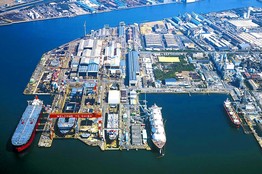
Modern shipbuilding makes considerable use of prefabricated sections. Entire multi-deck segments of the hull or superstructure will be built elsewhere in the yard, transported to the building dock or slipway, then lifted into place. This is known as "block construction". The most modern shipyards pre-install equipment, pipes, electrical cables, and any other components within the blocks, to minimize the effort needed to assemble or install components deep within the hull once it is welded together.
Ship design work, also called naval architecture, may be conducted using a ship model basin. Previously, loftsmen at the mould lofts of shipyards were responsible for taking the dimensions, and details from drawings and plans and translating this information into templates, battens, ordinates, cutting sketches, profiles, margins and other data.[29] However, since the early 1970s computer-aided design (CAD) became normal for the shipbuilding design and lofting process.
Modern ships, since roughly 1940, have been produced almost exclusively of welded steel. Early welded steel ships used steels with inadequate fracture toughness, which resulted in some ships suffering catastrophic brittle fracture structural cracks (see problems of the Liberty ship). Since roughly 1950, specialized steels such as ABS Steels with good properties for ship construction have been used. Although it is commonly accepted that modern steel has eliminated brittle fracture in ships, some controversy still exists.[31] Brittle fracture of modern vessels continues to occur from time to time because grade A and grade B steel of unknown toughness or fracture appearance transition temperature (FATT) in ships' side shells can be less than adequate for all ambient conditions.
DoD-Department of Defense-For perusal, approval.
Program Title
Navy Shipbuilding (Military/Merchant)
 Q) What is the whole process in a shipbuilding?
Q) What is the whole process in a shipbuilding?
Q) Can a ship really be unsinkable?
Q) Is the program purpose clear?
Q) How much will it cost?
Q) What will it look like?
Q) Does the program address a specific interest, problem or need?
Q) Is the program designed to have a significant impact in addressing the interest, problem or need?
Q) Is the program optimally designed to address the interest, problem or need?
Q) Does the program have a limited number of specific, ambitious long-term performance goals that focus on outcomes and meaningfully reflect the purpose of the program?
Q) Does the program have a limited number of annual performance goals that demonstrate progress toward achieving the long-term goals?
Q) Do all partners (grantees, sub-grantees, contractors, etc.) support program planning efforts by committing to the annual and/or long-term goals of the program?
Q) Does the program collaborate and coordinate effectively with related programs that share similar goals and objectives?
Q) Are independent and quality evaluations of sufficient scope conducted on a regular basis or as needed to fill gaps in performance information to support program improvements and evaluate effectiveness?
Q) Is the program budget aligned with the program goals in such a way that the impact of funding, policy, and legislative changes on performance is readily known?
Has the program taken meaningful steps to address its strategic planning deficiencies?
Q) Are acquisition program plans adjusted in response to performance data and changing conditions?
Q) Has the agency/program conducted a recent, meaningful, credible analysis of alternatives that includes trade-offs between cost, schedule and performance goals?
Q) Does the agency regularly collect timely and credible performance information, including information from key program partners, and use it to manage the program and improve performance?
Q) Are Federal managers and program partners (grantees, subgrantees, contractors, etc.) held accountable for cost, schedule and performance results?
Q) Are all funds (Federal and partners') obligated in a timely manner and spent for the intended purpose?
Q) Does the program have incentives and procedures (e.g., competitive sourcing/cost comparisons, IT improvements) to measure and achieve efficiencies and cost effectiveness in program execution?
Q) Does the agency estimate and budget for the full annual costs of operating the program (including all administrative costs and allocated overhead) so that program performance changes are identified with changes in funding levels?
Q) Does the program use strong financial management practices?
Q) Has the program taken meaningful steps to address its management deficiencies?
Q) Has the program established appropriate, credible, cost and schedule goals?
Q) Has the program conducted a recent, credible, cost-benefit analysis that shows a net benefit?
Q) Does the program have a comprehensive strategy for risk management that appropriately shares
Q) Has the program demonstrated adequate progress in achieving its long-term outcome goal(s)?
Q) Does the program (including program partners) achieve its annual performance goals?
Q) Does the program demonstrate improved efficiencies and cost effectiveness in achieving program goals each year?
Q) Does the performance of this program compare favorably to other programs with similar purpose and goals?
Q) Do independent and quality evaluations of this program indicate that the program is effective and achieving results?
Q) Were program goals achieved within budgeted costs and established schedules?
|
